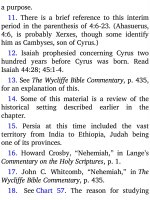Jensens survey of the old testament adam 78
Bạn đang xem bản rút gọn của tài liệu. Xem và tải ngay bản đầy đủ của tài liệu tại đây (150.06 KB, 4 trang )
contingent of Israelites, interpret some Hebrew
words not as numerical gures but as other
designations. For example, it is contended that
the consonants 1-p should be read as allup,
translated “captain,” and not as elep, translated
“thousand.” (See J. A. Thompson, “Numbers,” in
The New Bible Commentary, p. 169.)
7
Deuteronomy: Book of
Remembrance
This last book of the Pentateuch records
Moses’ addresses to the nation of Israel as
they ‘prepared to enter the promised land of
Canaan. “These are the words which Moses
spoke to all Israel across the Jordan in the
wilderness” (Deut 1:1). The closing words of
the book are an epitaph memorializing the
great patriarch’s ministry:
Since then [the time of Joshua] no
prophet has risen in Israel like Moses,
whom the LORD knew face to face, for
all the signs and wonders which the
LORD sent him to perform in the land of
Egypt against Pharaoh, all his servants,
and all his land, and for all the mighty
power and for all the great terror
which Moses performed in the sight of
all Israel (34:10-12).
I. PREPARATION FOR STUDY
1. Read Deuteronomy 31:24-26. Where
were the Levites instructed to deposit the
Scriptures which Moses had written? Now
read 2 Kings 22:1-13. This action took place
more than seven hundred years after Moses
wrote the scrolls. In what building were the
writings found? What was the concern of
King Josiah?
2.
Read
Exodus
20.
The
Ten
Commandments were one portion of the
earlier Scriptures which Moses repeated in
his Deuteronomy addresses.
3. Read the last verse of Numbers (36:13).
Compare it with the opening verse of
Deuteronomy.









